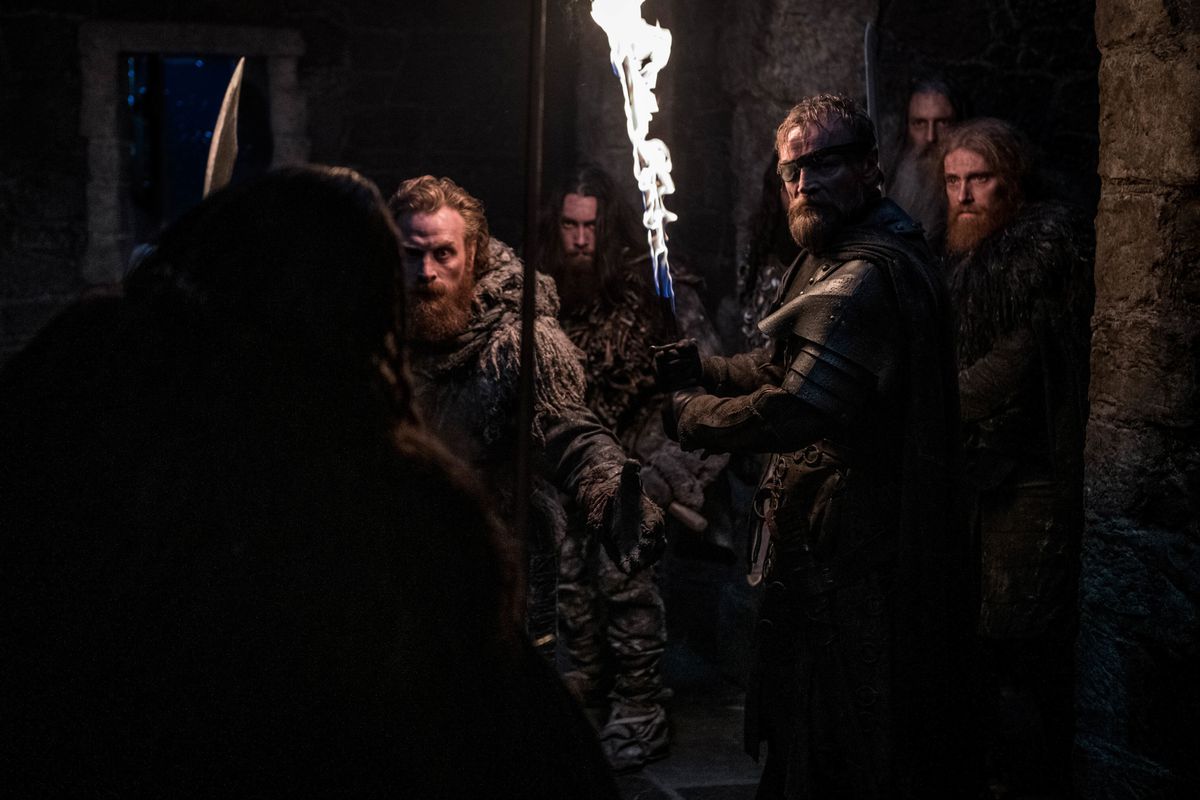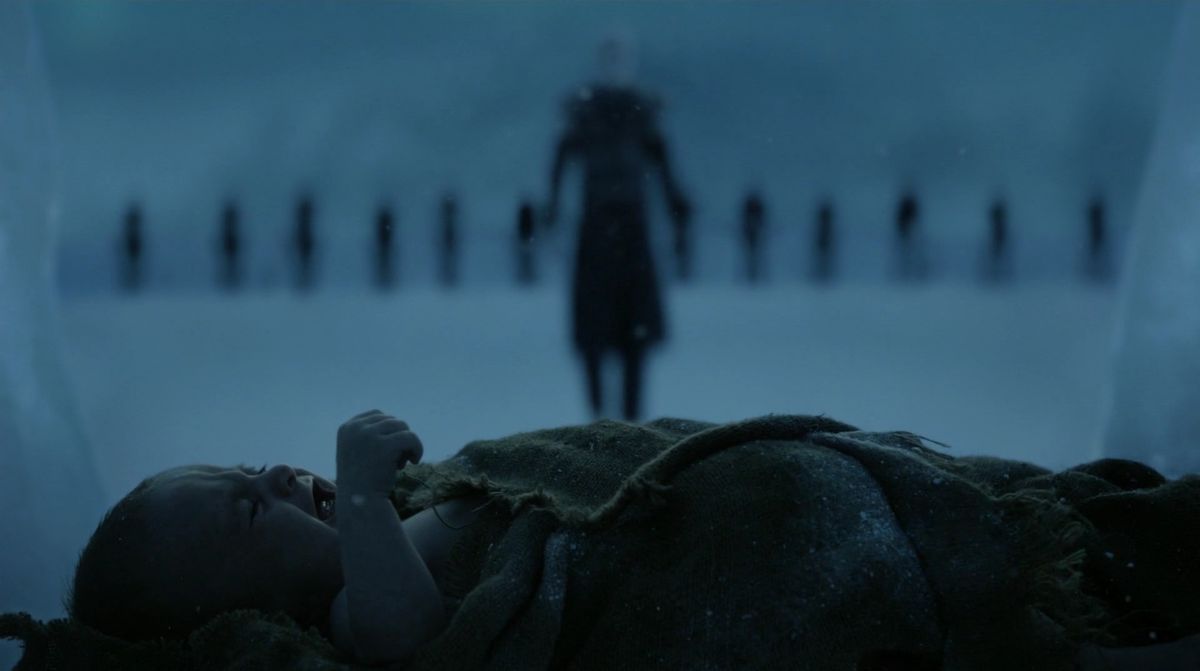The Night King and his army of White Walkers are coming — but why? In season 7 of Game of Thrones, an impossible predicament with blurry motivation jammed a metal bar between the spokes of Westeros’ spinning political wheel, forcing mortal enemies into the arms of their most hated adversaries. The season 8 premiere, “Winterfell,” reminded us that the upcoming battle is not with a wave of brainless zombies. The Night King left a message, and what it means could be life or death for our heroes.
At the end of “Winterfell,” Beric, Tormund, and friends venture out to investigate Last Hearth, only to find Lord Ned of House Umber pinned to a wall, surrounded by severed arms, his house rendered extinct by the Night King’s army. A blood-curdling scream from the undead boy prompts Beric to thrust a sword into him, engulfing the display in flames.
Beyond being frightening, the atmosphere of this moment was made more eerie by the knowledge that the Night King went out of his way to create this grisly scene. And it’s not the first time: We’ve seen this spiral motif at multiple points in Game of Thrones, adopted by the Walkers from the stone arrangement around the weirwood tree where the Children of the Forest created the Night King. It was later found on the cave walls of Dragonstone.
There’s a theory that the White Walker swirl is a mutated version of the Targaryen sigil, an answer-chasing hope that has only heated up since Beric set the mutilated-body calling card aflame. The potential connection between the Night King and the Targaryen bloodline is even more interesting when you consider one of the final shots of season 7, in which we saw the White Walkers head south after destroying the Wall, forming the shape of the Stark sigil as they marched. Spooky. As is so often the case with Thrones, it’s easy to get lost discussing the puzzling symbolism of the choices — especially the White Walker spiral — but the most curious part of the big season 8 reveal is what’s in the middle of it: a child.

Helen Sloan/HBO
The Night King made a bloody example out of Ned Umber, but in the past, he has spared plenty of living people across the series, including Samwell Tarly and Bran. Hell, he could have wiped out both Jon and Dany when they went beyond the Wall, but instead, he chose to bide his time, using his spear to kill Viserion instead and then resurrecting the dragon. Clearly, there is some method behind the madness.
And the White Walkers are seemingly open to diplomacy with characters like Craster, who worshipped the Night King and his legion as gods, cutting a sinister deal in which he sacrificed his offspring to secure his own safety.
What does the Night King want? If there’s any desire seemingly driving his actions, it’s children. He can make millions of wights out of corpses, but he can’t simply create new White Walkers. As we know from Bran’s vision and Leaf’s confession, the Walkers are all formerly human, and the more organized members we’ve seen clad in black armor seem obsessed with creating new recruits by turning the naive eyes of children icy blue during infancy.
Perhaps the Night King and his troops aren’t so different from the political class fortifying Winterfell as we speak. Their existence threatened, they want to survive, and this is the only way to prolong their species. When Sam and Gilly escaped the mutineers at Craster’s Keep in season 3, a Walker followed suit and tried to kidnap her surviving son, forcing Sam to stab the undead being (and learn the true power of dragonglass). This was one of the first instances of the Walker’s methodic hunt, spurred on by a broken pact with Craster and a missing child, Sam Jr., that was initially promised to be theirs. By using a child’s body to send his gruesome warning to the group entering Last Hearth, the Night King could be sending an overt message about his mission.

HBO
In the books, Bran is told stories of a “Night’s King” by Old Nan. This king, a Stark from the Age of Heroes, fell in love with a White Walker “with skin as white as the moon and eyes like blue stars.” Nan notes that “when he gave his seed to her he gave his soul as well.” This fabled king enacted rule from the decrepit Nightfort, committing all sorts of vile acts with his lover as his queen. Maybe not a great bedtime story, but helpful for all of us interested in White Walker history.
According to legend, the Night’s King also sacrificed children to the undead in order to keep them at bay, and that’s why his triumphs were stripped from the history books. He was eventually dethroned by a “Stark of Winterfell.”
A Song of Ice and Fire author George R.R. Martin has separated this character from Game of Thrones’ Night King (notice the lack of apostrophe) in interviews, but it’s still very yummy food for thought. The cyclical, historical parallel of a sordid pact with the Walkers has great potential to appear again. Only this time, it could be a sacrifice that decides the fate of Westeros.
With Dany, Jon, Sansa, and Cersei all dealing with political pressures as the Night King marches south, the remaining question is whether the surviving leaders will condemn their troops to die fighting to break the wheel or succumb to the sacrificial ultimatum, enabling the cycle once more to keep the undead at bay.
As well as an army of infants to survive his loyal guard, perhaps the Night King wants the ultimate heir apparent to succeed him. Whose baby? There are a few options, but one could be an apocryphal child born of ice and fire, one who might be imagined to lead a new unified Westeros. With five episodes to go, the only thing we know for sure is that the White Walkers’ mystery leaves plenty of room for everything we think we know to be upended.
Jordan Oloman is a freelance writer based out of Newcastle, England’s equivalent of Winterfell. You can find his writing on games and entertainment in Eurogamer, Kotaku, GamesRadar, and more. Follow him on Twitter @JordanOloman.




















![[Book Review] The Blade Itself (The First Law Trilogy) by Joe Abercrombie](https://bendthekneegot.com/wp-content/uploads/2018/01/1516047103_maxresdefault-218x150.jpg)

















